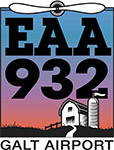The Aeronautical Information Manual (AIM) encourages pilots to use a standard traffic pattern but there are in fact no regulations prohibiting straight-in approaches at non-towered airports because the FAA does not regulate pattern entry procedures.
However, just like any other approach to an airport environment, pilots executing a straight-in approach should not disrupt the flow of other traffic arriving at and departing from the airport.
Pros and cons
The main advantage of a straight-in approach is convenience. For example. if you are east of an airport and landing to the west then a straight-in approach is the quickest and most economical way to get there. Towered airports use this type of approach any time it is appropriate and IFR traffic will usually be flying straight-in to land from about ten miles away.
The downside of flying straight-in is you don’t get a good view of the airport environment, other traffic in the pattern or the windsock before you land.
A lot of pilots struggle with straight-in approaches due to the lack of practice with this procedure during Private Pilot training. What makes the straight-in approach difficult is the lack of the usual visual clues we rely on in a standard traffic pattern. When we fly downwind, base and final we know exactly when to slow down, reduce power, lower the flaps, etc. We are familiar and comfortable with this procedure because we practice it over and over again. But we might rarely be asked to fly straight-in by our flight instructors or controllers at towered airports.
When to descend
A straight-in approach isn’t as complicated as you might think. Essentially it is just a long final to land, but just like any other technique in flying, you have to know what to do and when. Assuming there are no obstacles, plan to be level at 1,000 feet AGL and slowed to your usual downwind speed around five miles from the airport. Execute your approach checklist items, then begin your descent 3.5 nautical miles from the airport, as indicated on your GPS. If you don’t have a GPS, find a prominent feature you can see from the air on your aeronautical chart to determine a 3.5 mile position from the center of the airport.
Using this technique will give you roughly a three-degree glide slope which is the typical descent profile used by most instrument approaches. If in any doubt about obstacles such as towers or terrain on the approach to an unfamiliar runway you can consult the instrument approach plate, if there is one, to determine if a steeper approach is necessary.
Configuring the airplane
If you divide the descent distance roughly into thirds you can plan your changes in airspeed and airplane configurations exactly how you would do it in a standard approach;
- 3.5 miles out reduce power, lower the gear (if not fixed), add flaps, start your descent.
- 2.5 miles out, slow to your usual base airspeed and add a notch of flaps (if required).
- 1.5 miles out, slow to your final airspeed and add the last notch of flaps (if required).
The last part is just a normal short final so it won’t look any different than your usual approach.
I highly recommend getting comfortable with this type of approach in case you are ever required to perform it at a towered airport. However, it does require some extra vigilance and coordination with other traffic, and if there are a lot of other airplanes flying the standard traffic pattern it might be a better idea to get in line with everyone else and join the downwind.
Beth Rehm, CFI

